While almost every component on an eBike is essential in its own way, you could make a great argument that after the frame, the next most crucial element is the wheel setup. Wheels will significantly determine your speed, stability, handibility, and numerous other performance factors while riding. Wheel size is critical when it comes to understanding and comparing eBikes.
However, how important wheels is a hotly contested issue–especially among serious cyclists. Wheel size, inflation ranges, tire construction, rim design, and other factors all have to be considered, along with where you’re riding, the rider’s size, skill level, and more. No two cyclists will perform the same on an eBike. And depending on smaller factors like the weather, no cyclist will have the same experience on a trail.
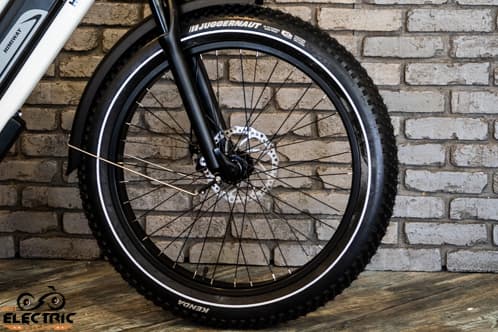
That’s why we felt it was imperative to write this post, especially for those new or unfamiliar with the mechanics of eBike wheels. Below, you’ll find out how wheels are measured, some general rules when it comes to performance, and a few other vital pieces of information to help you understand wheel size.
If you’re still confused or would like to learn more after reading, we invite you to read our other blog posts or leave a comment at the end of our post. While our review team might have slightly different answers, we do our best to provide a comprehensive overview of what you need to know when it comes to eBike wheel size!
How are eBike Wheels Measured?
Before we understand how it impacts performance, we have to discuss why wheel size is problematic. The measurement system for measuring tires is debated continuously among cycling enthusiasts, with no universal measurement system used globally. Contrary to what you might expect, two tires with the same measurements might be different sizes and offer different performance.
Let’s explain how wheels are generally measured. Wheel size is expressed in two measurements, consisting of the wheel’s diameter and the tire’s width. In the United States and several other western countries, this is expressed in inches with the diameter first and the width second.
However, for European countries and many International Organization for Standardization members, millimeters are used instead, with the width expressed first and the diameter second. Conversion systems are useful for quickly switching from one system to another, but since many bike companies round the number, it won’t produce an exact result often. As an American-based cycling review team, we will be using the American standard for this blog post.
To measure the diameter, the first number for American wheel size classification and the second number for ISO measurements, start by attaching your tape measure to the center of the wheel. Extend the tape measure directly to the tire’s outer edge and double the number for the American wheel size diameter. If you want an ISO measurement, you will only measure to the tire’s inner edge before doubling it, resulting in an ISO diameter.
Measuring the diameter is why American tires often fail to produce an exact conversion to ISO measurements and vice versa, due to where they stop measuring. Both systems fail to address tire thickness; tires with thinner rims and extra-thick tires can technically produce the same measurement as tires with extra thick rims but narrower tires. If you’re wondering why two wheels with the exact measurements look different, this is the reason why.
Thankfully, measuring the tire width is a bit easier. The tire width is the second number for American wheel measurement and the first number for ISO measurement systems. Measuring in either method is the same since you simply place the measure on one side of the tire, pull it across a flat section of the tire tread, and stop on the other edge of the tire.
Because the measurement ends at the same place, you will have a more accurate measurement if you convert from inches to millimeters or vice versa as you switch measurement systems.
Now that you understand how wheels are measured, you might be wondering how wheel size impacts performance. As we’ve discussed earlier in our post, many different factors impact riding performance, so what we say here might not match what you’ll feel when you ride. Even so, these general rules are broadly accepted by the greater cycling community and will typically prove themselves correct overtime, even if you experience the occasional exception to the rule.
How Will Large Wheels Impact my Cycling Performance?
While there isn’t an exact system for classifying wheel size, wheels that are 22’’ and larger, with a 2.15’’ width and larger, are typically considered big wheels. Large wheels are more common than smaller wheels and are usually included with bikes that require greater stability or a smoother cycling experience.
Large wheels’ main advantage is that their size helps them overcome obstacles more easily, providing a smoother overall riding experience. Large wheels roll over bumps easier than small wheels, and they won’t vibrate, shake, or sink as much into loose dirt, potholes, and other sunken road sections compared to smaller wheels.
Larger wheels retain inertia better, allowing you to coast more once you’ve built up your speed. As a result, larger wheels often lead to greater range over small wheels, though your range will suffer as a result if they are too large.
Advantages of Large Wheels on an eBike:
- Smoother riding experience.
- Greater traction support.
- Better at climbing.
- Better inertia retention.
- Better handling at high speeds.
- Less power is needed to maintain inertia.
- Typically results in an excellent battery range.
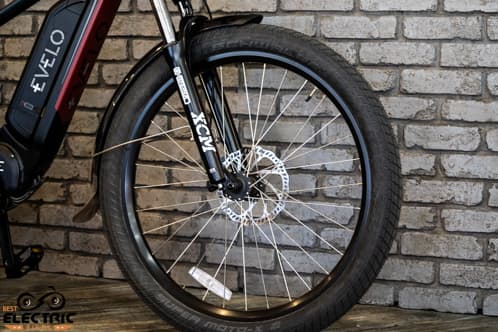
How Will Small Wheels Impact my Performance?
Conversely, while many cyclists debate what should be considered a small wheel, wheels that are 20’’ and smaller, with a 1.85’’ width and thinner, are typically regarded as small wheels. While they might not be as standard, you do find small wheels more often on specialized bikes, such as folding and racing bicycles.
Smaller wheels are very popular with city eBikes because their main advantages are greater maneuverability and acceleration over larger wheels. Not only will you find it easier to handle your eBike overall, but because of its smaller size, the bike is lighter and easier to fit through narrow doors and passageways as well.
Smaller wheels don’t require as much energy to turn, so they accelerate quicker and don’t require as much effort to pedal at low speeds. While they might not retain inertia as well, the smaller tire does have some energy savings in that you don’t need as large of a motor on a small eBike to help power it either.
Advantages of Small Wheels on a eBike:
- Superior eBike handling.
- Greater acceleration.
- Lighter bike weight.
- Easier to maneuver through doors and tight alleys.
- Less power to build up inertia initially.
- Typically results in a lighter, less expensive motor being included.
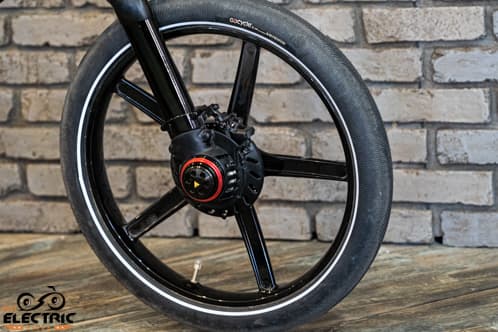
What Should I Know About Custom/Hybrid Wheel Sizes?
Typically, tall wheels will get paired with thicker tires, while short wheels get paired with thinner tires. This isn’t always the case, and as you’ll read about in our next section, there are specific bikes with tall, thin wheels or short, fat wheels.
Generally, a hybrid wheel aims to balance the performance advantages, such as greater stability, without compromising on acceleration or handling. If you’re confused or unsure if a wheel is a good fit for a particular frame or type of eBike, reach out to us and leave a comment with any questions.
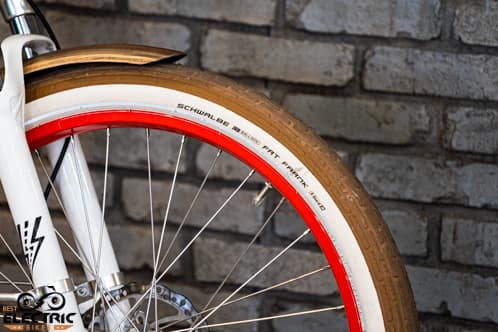
Which Wheel Size Should I Get for My eBike?
Budget: When it comes to a budget eBike, generally it’s fine sticking with the wheels that come with the stock eBike model. If you’re building your own eBike, smaller eBike wheels will be less expensive, but the cost difference between a small and large wheel isn’t considerable. Ultimately, you want to consider what your eBike is used for and determine your wheel size by purpose rather than by price.
City Commuters: City commuters are built with both wheel sizes, and it’s not a surprise to find a wheel between the two sizes. Larger wheels maintain momentum better, while smaller wheels are easier to accelerate. Smaller wheels will provide better handling and maneuverability, especially at low speeds.
Keeping up with traffic at high rates is easier to control overall if you have an eBike with a larger wheel size. As such, you’ll find all kinds of city commuters with all sorts of sizes, especially if it’s a folding, hybrid, or long-distance commuter eBike.
Mountain Bikes: On a mountain bike, you are better suited to having a larger wheel size. Large wheels will have better traction and climbing abilities, handle bumps and potholes better, and provide a smoother riding experience overall. Unless it’s a hybrid eBike, you will want to stick with larger, wider tires when you’re shopping or building mountain bikes.
Racing/Cross-Country Bikes: Racing and cross-country eBikes are similar to city commuters, but with an extra emphasis on speed; they often wind up with a unique wheel setup. Racing and cross-country bikes typically have 26’’ diameter wheels and larger, but 1.85’’ wide wheels and thinner.
The larger diameter retains momentum better, while the narrower tire results in greater acceleration and less effort required to initially build up inertia. Bike races often have particular wheel requirements, but if you want to buy or build your own custom size try to look for taller yet thinner wheels.
Cruiser Bikes: The opposite of racing and cross-country bikes, cruiser bikes typically have a mixture of 22’’ and shorter wheels and smaller with 2.25’’ and wider tires. The shorter size is better suited for riding through sand and on boardwalks, while the extra width helps with stability and for having a more comfortable riding experience. Cruisers with additional cargo support might have tall and thick tires, but it will depend on the total weight support you need for your cruiser bike.
Family/Cargo Bikes: Family and cargo eBikes are built with weight support in mind, and even if they had highly maneuverable wheels, they don’t have great handling due to their large frame size. As a result, many eBike companies will stick huge, fat tires on family and cargo bikes, often in the 28’’ and 2.75’’+ range. You’re not going to have great acceleration, but you’re going to have a smooth and stable experience while you ride with your electric bike.
How do eBike Wheels Different from Traditional Bicycle Wheels?
When it comes to design, the majority of eBike wheels will be almost the same as you find on a traditional bicycle, especially if you have a mid-drive motor. If you have a hub-drive engine, you must swap out or rework the wheel to fit the motor.
If you take your eBike to an experienced bike mechanic, they can install the motor without too much trouble. The overall performance of a wheel on a bicycle and an eBike is mostly going to be the same as well, though there are two significant differences to be aware of.
Weight. An eBike weighs more than a traditional bicycle with the same dimensions. There are several components on an eBike that a conventional bike doesn’t have, including the motor, battery, and other electronic parts. As a result, an eBike compared to a traditional bicycle is often going to be 15 to 20 pounds heavier.
However, some bikes are heavier due to extra features. In contrast, others barely change due to their lightweight electronic setup. Even so, the added weight means that larger wheels are often included with eBikes. Even if the wheels are the same, you won’t have the same feel compared to a traditional bicycle.
Speed. While eBikes are slower to accelerate with the motor off, eBikes are going to outrace a traditional bicycle with the motor on. Depending on whether you have a class 1, 2, or 3 eBike, your bike will accelerate to 20 or 28 MPH within a few seconds of riding before the motor shuts off.
Since electric bikes often ride at higher speeds, they require greater puncture protection to reduce the risk of suffering a severe blowout. However, the added puncture protection means that you often wind up with a heavier and thicker tire. Tires typically used for traditional bicycles are not enough to be safely used on an electric bike.
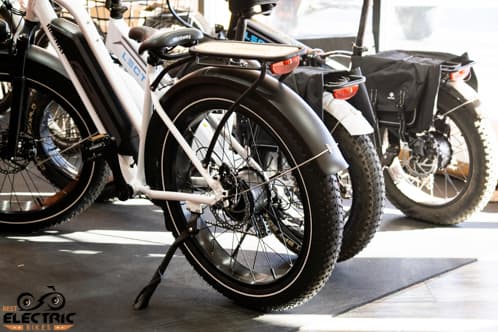
When Should I Swap out the Wheel on my eBike?
As a general rule, most mainstream and popular manufacturers have designed their eBike with a specific purpose in mind. The wheels and tires included with their eBikes provide optimal riding performance, especially for those within the recommended height and weight range for the bike.
We discuss the wheel setup on every eBike we review. Still, as long as you’re buying from a reputable eBike manufacturer, the included wheel is going to be appropriate for your eBike. Depending on how the frame is designed, you might never find a different sized wheel compatible with your eBike frame.
But, there might be a couple of reasons why it’s worth making the investment and swapping out the wheel on your eBike. Having a damaged wheel is an apparent reason. Another reason would be because you’re changing where you want to ride.
While hybrid eBikes are designed to be ridden in multiple environments, they’re not going to excel to the same degree as a real, dedicated electric commuter, electric racing, or electric mountain bike. If you find yourself riding in one environment for extended periods, swapping out the wheels is beneficial.
Another significant factor to consider is your seasonal weather. While many cyclists store their bikes once the winter snow hits, others find snow to be as fun as riding on a sunny, clear day.
However, the more snow and ice you have on the ground, the more you’ll need wheels designed for the snow if you want to stay safe. If you live in a dry area or don’t intend to ride in winter, investing in snow tires or wheels can be a waste of money. However, if riding through a winter wonderland is your way of having holiday fun, we recommend considering a set of snow tires or wheels (depending on your frame style).
What Should I Know about Wheel PSI?
There are many different things to know about eBike wheels and tires, and we want to mainly focus on wheel sizes in this post. However, PSI is such an important factor and is interconnected with eBike wheels that we include it as a supplement to our main post. We also plan on publishing a more extended discussion of tire PSI, along with blog posts dedicated to other matters revolving around eBike wheels and tires.
The tire on your wheel rim is inflated with air, and depending on the design, it will have a different air pressure recommendation. Air pressure in a tire is measured by pounds per square inch, often shortened to PSI.
Other PSI leads to different tire performance, with many eBike tires often having a 15 to 35 PSI range you set your tire pressure to. While you won’t repeatedly need to change your tire pressure, remembering to do so before you ride will lead to optimal cycling performance.
Your bike tire will have the recommended PSI range printed on the tire sidewall. If the PSI range is faded, or if you’re curious about how PSI affects your cycling performance, here is a small chart detailing the typical tire size and PSI combination you’ll find, along with their intended purposes:
Small Tires: 5 to 35 PSI, typically meant for cruiser and mountain eBikes.
Medium/Average Tires: 25 to 55 PSI, typically meant for hybrid or all-around style eBikes.
Large Tires: 45 to 75 PSI, typically meant for the city commuter and racing eBikes.
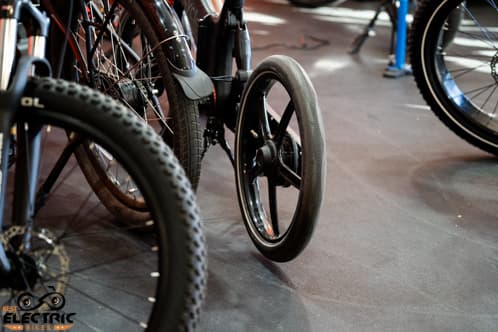
Conclusion: Stick with the Stock Wheel, or Try Your Own!
If you want safe, consistent, and reliable performance from your new eBike, then using the stock wheel size for your eBike is going to provide optimal performance in most cases. If you’re building your own eBike or want to experiment and see how wheels impact the overall performance, then experimenting with different wheel sizes can provide a new way to enjoy your electric bike.
Larger wheels will provide ability and traction. Shorter wheels will improve your overall acceleration and maneuverability. The more you learn about wheels, and the more you try different wheel sizes, the more experienced and knowledgeable you’ll be when it comes to becoming an eBike expert!
Thank you again for reading, and be sure to leave a comment, question, or feedback you have below for our team at Best Electric Bikes!


Leave a Reply